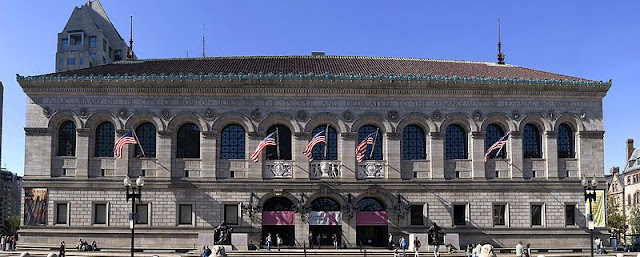 |
| Stanford White in a Stanford White Frame; framed by the press? |
The last decade of the nineteenth century is often referred to as the "gay nineties." The last decade of 20th century has been called the "gay nineties" too, but obviously with a different connotation. The period 1890 to 1900 is usually pictured as, first of all, lighthearted, as well as frivolous, ornate, pretentious, rambunctious, pretty, and petty. It was a time of overblown expectations, elegant male dominance, swashbuckling financial adventurism, delicate feminine retreat, warm family values, Victorian morality, and barely concealed decadence. In the arts, it was a time of John Singer Sargent, Richard Morris Hunt, Louis Comfort Tiffany, Augustus Saint-Gaudens, Louis Sullivan, and perhaps the man whose designs and lifestyle singly personify the "gay nineties" more than any other individual--Stanford White.
 |
| H.H. Richardson's Woburn (Mass.) Public Library, 1877, contrasts sharply with the nearby Boston Public Library built 23 years later. |
White was born in 1853, the son of a New York theater critic. At an early age, he showed a talent for painting and drawing, but was advised by the painter John La Farge that "...the chances of gaining recognition were faint, and those of making money, fainter still." Reluctantly the energetic, nineteen-year-old, red-haired youth became a draftsman, intent on eventually becoming an architect at a time when architects were suspected of being little more than glorified carpenters. He was fortunate, his apprenticeship was served under the stringent tutelage of the architectural magnum opus, Henry Hobson Richardson himself. While working for the "Great Mogul" as White called him, he met fellow apprentice Charles Follen McKim. Together, having saved a small amount from their $8 per week salaries, the two took off a summer to hit the art and architecture trail of high adventure in Europe. There they met Augustus Saint-Gaudens, already a successful sculptor busily engaged in sculpting monuments to Civil War legends. After what turned out to be almost a year of soaking up European culture and styles, White and McKim returned to the U.S. McKim joined forces with William R. Mead and William Bigelow to form an architectural firm. When Bigelow was forced to liquidate his holdings in the firm to satisfy a divorce settlement, McKim recommended Stanford White as the new junior partner.
 |
Photo by Eric Baestscher Boston Public Library, 1895, McKim, Mead & White |
 |
| Old Madison Square Garden, 1825, McKim, Mead, and White (demolished 1968) |
 |
| Old Pennsylvania Station, New York City, 1903-10, McKim, Mead, & White (demolished 1963) |
It was an excellent choice. Over then next three decades as McKim, Mead, and White became the leading architectural firm in the leading economic area of the country, White became its flamboyant poster boy, McKim its academically grounded breadwinner, and Mead its stern taskmaster, serving, as he put it, "...to keep his partners from making damn fools of themselves." Their legendary works included the Boston Public Library (by McKim), the old Madison Square Garden (White's baby), and the enormous Pennsylvania Station (primarily McKim's work). White was a socialite workaholic who literally designed anything asked of him--buildings, monuments, yachts, interiors, magazine covers, parades, banquets, restaurants, even items as mundane as picture frames (top). He kept such a whirlwind business and social schedule he was probably the first businessman to see the automobile as a business necessity. So it was when, on the night of June 25, 1906, as he sat alone at his customary front table in Madison Square Garden watching a stage show, he was shot three times by the Pittsburgh millionaire, Harry K. Thaw, who claimed White had "despoiled" his wife. In the scandal that followed, Thaw was acquitted of the crime by reason of insanity while White, the victim, was convicted in the press, if not the courtroom, of just about everything from rape to poor taste.
No comments:
Post a Comment